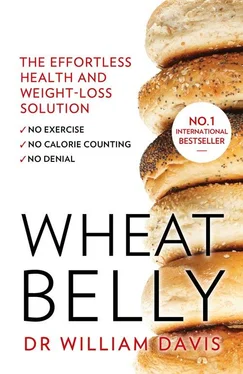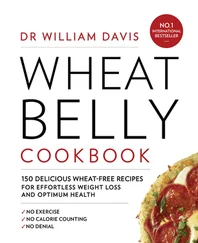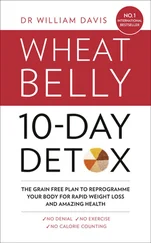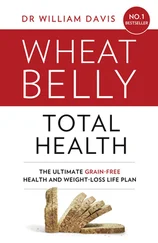Of all the grains in the human diet, why only pick on wheat? Because wheat, by a considerable margin, is the dominant source of gluten protein in the human diet. Unless they’re Euell Gibbons (Texas-born champion of natural diets in the 1960s), most people don’t eat much rye, barley, spelt, triticale, bulgur, kamut or other less common gluten sources; wheat consumption overshadows consumption of other gluten-containing grains by more than a hundred to one. Wheat also has unique attributes those other grains do not, attributes that make it especially destructive to our health, which I will cover in later chapters. But I focus on wheat because, in the vast majority of American diets, gluten exposure can be used interchangeably with wheat exposure. For that reason, I often use wheat to signify all gluten-containing grains.
The health impact of Triticum aestivum , common bread wheat, and its genetic brethren ranges far and wide, with curious effects from mouth to anus, brain to pancreas, Appalachian housewife to Wall Street arbitrageur.
If it sounds crazy, bear with me. I make these claims with a clear, wheat-free conscience.
NUTRI-GROAN
Like most children of my generation, born in the middle of the twentieth century and reared on Wonder Bread and Devil Dogs, I have a long and close personal relationship with wheat. My sisters and I were veritable connoisseurs of sugary breakfast cereals, making our own individual blends of Trix, Lucky Charms and Froot Loops and eagerly drinking the sweet, pastel-hued milk that remained at the bottom of the bowl. The Great American Processed Food Experience didn’t end at breakfast, of course. For school lunch my mum usually packed peanut butter or bologna sandwiches, the prelude to cellophane-wrapped Ho Hos and Scooter Pies. Sometimes she would throw in a few Oreos or Vienna Fingers, too. For supper, we loved the TV dinners that came packaged in their own foil plates, allowing us to consume our battered chicken, corn muffin, and apple brown betty in front of the TV.
My first year of college, armed with an all-you-can-eat dining room ticket, I gorged on waffles and pancakes for breakfast, fettuccine Alfredo for lunch, pasta with Italian bread for dinner. Poppy seed muffin or angel food cake for dessert? You bet! Not only did I gain a hefty spare tire around the middle at the age of nineteen, I felt exhausted all the time. For the next twenty years, I battled this effect, drinking gallons of coffee, struggling to shake off the pervasive stupor that persisted no matter how many hours I slept each night.
Yet none of this really registered until I caught sight of a photo my wife snapped of me while on holiday with our kids, then ages ten, eight, and four, on Marco Island, Florida. It was 1999.
In the picture, I was fast asleep on the sand, my flabby abdomen splayed to either side, my second chin resting on my crossed flabby arms.
That’s when it really hit me: I didn’t just have a few extra pounds to lose, I had a good thirty pounds of accumulated weight around my middle. What must my patients be thinking when I counselled them on diet? I was no better than the doctors of the sixties puffing on Marlboros while advising their patients to live healthier lives.
Why did I have those extra pounds under my belt? After all, I jogged three to five miles every day, ate a sensible, balanced diet that didn’t include excessive quantities of meats or fats, avoided junk foods and snacks, and instead concentrated on getting plenty of healthy whole grains. What was going on here?
Sure, I had my suspicions. I couldn’t help but notice that on the days when I’d eat toast, waffles or bagels for breakfast, I’d stumble through several hours of sleepiness and lethargy. But eat a three-egg omelette with cheese, feel fine. Some basic laboratory work, though, really stopped me in my tracks. Triglycerides: 350 mg/dl; HDL (‘good’) cholesterol: 27 mg/dl. And I was diabetic, with a fasting blood sugar of 161 mg/dl. Jogging nearly every day but I was overweight and diabetic? Something had to be fundamentally wrong with my diet. Of all the changes I had made in my diet in the name of health, boosting my intake of healthy whole grains had been the most significant. Could it be that the grains were actually making me fatter?
That moment of flabby realisation began the start of a journey, following the trail of crumbs back from being overweight and all the health problems that came with it. But it was when I observed even greater effects on a larger scale beyond my own personal experience that I became convinced that there really was something interesting going on.
LESSONS FROM A WHEAT-FREE EXPERIMENT
An interesting fact: whole-wheat bread (glycaemic index 72) increases blood sugar as much as or more than table sugar, or sucrose (glycaemic index 59). (Glucose increases blood sugar to 100, hence a glycaemic index of 100. The extent to which a particular food increases blood sugar relative to glucose determines that food’s glycaemic index.) So when I was devising a strategy to help my overweight, diabetes-prone patients reduce blood sugar most efficiently, it made sense to me that the quickest and simplest way to get results would be to eliminate the foods that caused their blood sugar to rise most profoundly: in other words, not sugar, but wheat. I provided a simple handout detailing how to replace wheat-based foods with other low-glycaemic whole foods to create a healthy diet.
After three months, my patients returned to have more blood work done. As I had anticipated, with only rare exceptions, blood sugar (glucose) had indeed often dropped from diabetic range (126 mg/dl or greater) to normal. Yes, diabetics became non diabetics. That’s right: diabetes in many cases can be cured – not simply managed – by removal of carbohydrates, especially wheat, from the diet. Many of my patients had also lost twenty, thirty, even forty pounds.
But it’s what I didn’t expect that astounded me.
They reported that symptoms of acid reflux disappeared and the cyclic cramping and diarrhoea of irritable bowel syndrome were gone. Their energy improved, they had greater focus, sleep was deeper. Rashes disappeared, even rashes that had been present for many years. Their rheumatoid arthritis pain improved or disappeared, enabling them to cut back, even eliminate, the nasty medications used to treat it. Asthma symptoms improved or resolved completely, allowing many to throw away their inhalers. Athletes reported more consistent performance.
Thinner. More energetic. Clearer thinking. Better bowel, joint and lung health. Time and time again. Surely these results were reason enough to forgo wheat.
What convinced me further were the many instances in which people removed wheat, then permitted themselves a wheat indulgence: a couple of pretzels, a canapé at a cocktail party. Within minutes, many would experience diarrhoea, joint swelling and pain, or wheezing. On again, off again, the phenomenon would repeat itself.
What started out as a simple experiment in reducing blood sugars exploded into an insight into multiple health conditions and weight loss that continues to amaze me even today.
A RADICAL WHEAT-ECTOMY
For many, the idea of removing wheat from the diet is, at least psychologically, as painful as the thought of having root-canal treatment without anaesthesia. For some, the process can indeed have uncomfortable side effects akin to withdrawal from cigarettes or alcohol. But this procedure must be performed to permit the patient to recover.
Wheat Belly explores the proposition that the health problems of Americans, from fatigue to arthritis to gastrointestinal distress to obesity, originate with the innocent-looking bran muffin or cinnamon raisin bagel you down with your coffee every morning.
Читать дальше












